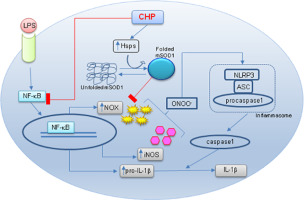Molecular and Cellular Neuroscience ( IF 3.5 ) Pub Date : 2018-11-13 , DOI: 10.1016/j.mcn.2018.11.002 Silvia Grottelli , Letizia Mezzasoma , Paolo Scarpelli , Ivana Cacciatore , Barbara Cellini , Ilaria Bellezza

|
Neuroinflammation, i.e. self-propelling progressive cycle of microglial activation and neuron damage, as well as improper protein folding, are recognized as major culprits of neurodegenerative diseases, such as amyotrophic lateral sclerosis (ALS). Mutations in several proteins have been linked to ALS pathogenesis, including the G93A mutation in the superoxide dismutase 1 (SOD1) enzyme. SOD1(G93A) mutant is prone to aggregate thus inducing both oxidative stress and neuroinflammation. In this study we used hSOD1(G93A) microglial cells to investigate the effects of the antioxidant and anti-inflammatory cyclic dipeptide (His-Pro) on LPS-induced inflammasome activation. We found that cyclo(His-Pro) inhibits NLRP3 inflammasome activation by reducing protein nitration via reduction in NO and ROS levels, indicative of lower peroxynitrite generation by LPS. Low levels in peroxynitrite are related to NF-κB inhibition responsible for iNOS down-regulation and NO dampening. On the other hand, cyclo(His-Pro)-mediated ROS attenuation, not linked to Nrf2 activation in this cellular model, is ascribed to increased soluble SOD1 activity due to the up-regulation of Hsp70 and Hsp27 expression. Conclusively, our results, besides corroborating the anti-inflammatory properties of cyclo(His-Pro), highlight a novel role of the cyclic dipeptide as a proteostasis regulator, and therefore a good candidate for the treatment of ALS and other misfolding diseases.
中文翻译:

Cyclo(His-Pro)抑制ALS小胶质细胞中的NLRP3炎性体级联反应
神经炎症,即小胶质细胞激活和神经元损伤的自我推进的进行性循环,以及蛋白质折叠不当,被认为是神经退行性疾病(如肌萎缩性侧索硬化症(ALS))的罪魁祸首。几种蛋白质中的突变与ALS发病机理有关,包括超氧化物歧化酶1(SOD1)酶中的G93A突变。SOD1(G93A)突变体易于聚集,从而诱导氧化应激和神经炎症。在这项研究中,我们使用了hSOD1(G93A)小胶质细胞来研究抗氧化剂和消炎性环二肽(His-Pro)对LPS诱导的炎症小体活化的影响。我们发现,cyclo(His-Pro)通过减少NO和ROS的水平来减少蛋白质的硝化作用,从而抑制NLRP3炎性体的活化,这表明LPS产生的过氧亚硝酸盐含量较低。过氧亚硝酸盐的低水平与导致iNOS下调和NO抑制的NF-κB抑制有关。另一方面,由于Hsp70和Hsp27表达的上调,环(His-Pro)介导的ROS衰减与该细胞模型中的Nrf2活化无关,归因于可溶性SOD1活性的增加。总之,我们的结果除了证实环(His-Pro)的抗炎特性外,还突出了环二肽作为蛋白稳定调节剂的新作用,因此是治疗ALS和其他错误折叠疾病的良好候选者。归因于Hsp70和Hsp27表达的上调,可溶性SOD1活性增加。总之,我们的结果除了证实环(His-Pro)的抗炎特性外,还突出了环二肽作为蛋白稳定调节剂的新作用,因此是治疗ALS和其他错误折叠疾病的良好候选者。归因于Hsp70和Hsp27表达的上调,可溶性SOD1活性增加。总之,我们的结果除了证实环(His-Pro)的抗炎特性外,还突出了环二肽作为蛋白稳定调节剂的新作用,因此是治疗ALS和其他错误折叠疾病的良好候选者。



























 京公网安备 11010802027423号
京公网安备 11010802027423号